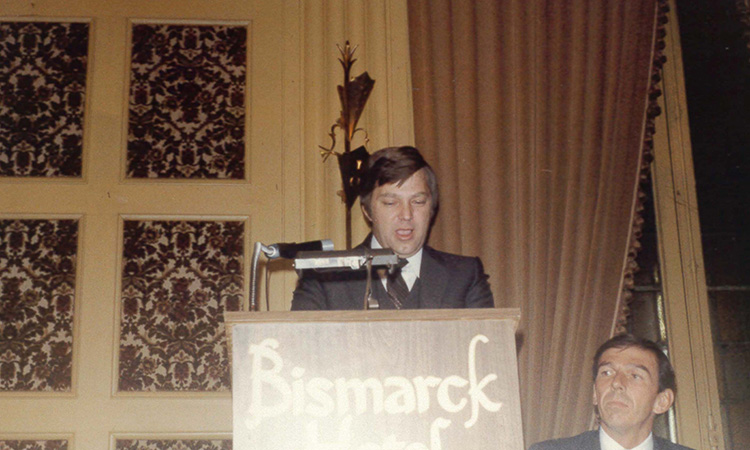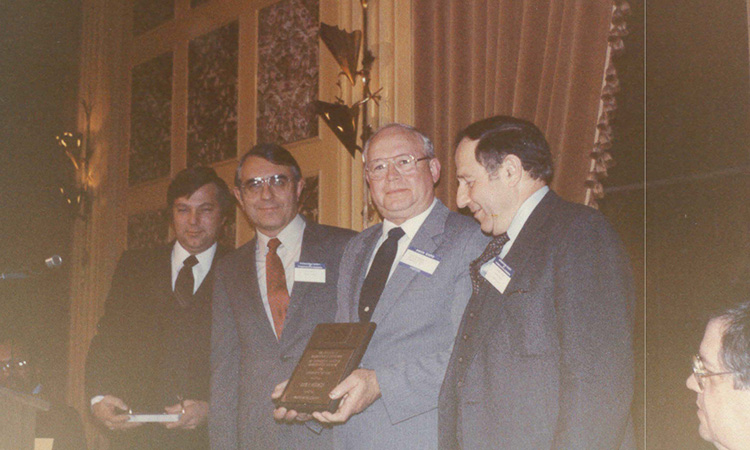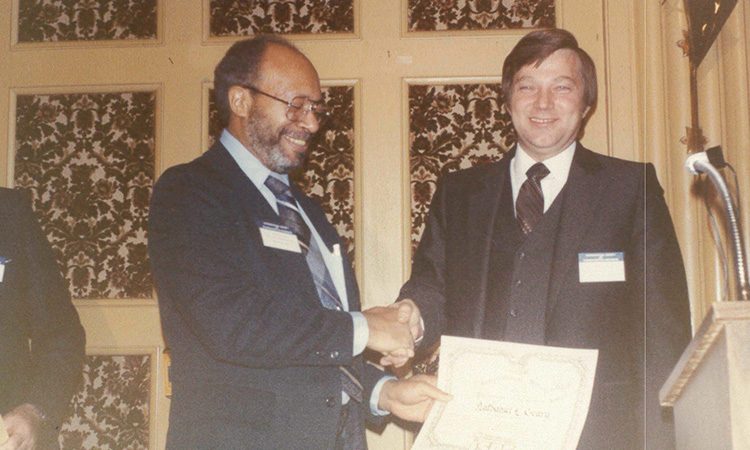Honoring James (Jim) O'Brien

The ISPE community is saddened by the passing of James (Jim) O'Brien, a founding member of ISPE and a luminary in the field of pharmaceutical engineering. Jim was a recognized expert in the design and engineering of pharmaceutical facilities, whose profound influence has shaped our industry.

Jim's legacy is one of dedication, innovation, and excellence. He was not only a mentor and leader but also an inspiration to many in our community. As ISPE remembers Jim, we celebrate his remarkable contributions to the field and his lasting impact on ISPE.
Jim was an accomplished leader in managing multimillion-dollar projects and delivering state-of-the-art research facilities on time and on budget. A recognized expert in applying engineering concepts to laboratories, he had extensive project management experience in both manufacturing and research facilities for the pharmaceutical and cosmetic industries. His worldwide knowledge was based upon his experience serving Fortune 500 companies in the US and on assignments throughout the US, South America, Canada, Europe, and Asia.
Jim began his career with Merck and Company, Inc. in the mid-1980s. There, his positions included Senior Facilities Project Engineer, Manager of Laboratory and Operational Projects, and Senior Project Engineer. He directed worldwide cross-functional work teams for Merck’s Research and Manufacturing Division laboratory, managing project execution from concept stage through commissioning/validation. He also has documented project descriptions, execution plans, funding package requests, and design development, and he has managed facility construction through commissioning/validation to turnover training.
Jim held a BS in mechanical engineering from the New Jersey Institute of Technology. He was a past Vice President, Executive Vice President, and President of ISPE, and also had served on the Board of Directors. Additionally, he served as chairman of the Society’s International Task Team for the development of the ISPE Good Practice Guide: Quality Laboratory Facilities.
ISPE has uncovered the following ISPE Member Spotlight, featuring an interview with Jim from nearly 20 years ago. We invite you to review this in-depth question-and-answer session for insights from Jim on his primary motivation for starting ISPE, his view on its growth and evolution in its first 25 years, reflections on his career, insights on his greatest passion, the best advice he ever received, and more.
ISPE Member Spotlight: James (Jim) O’Brien (iSpeak March 2005)
As ISPE celebrates its 25th anniversary, it’s fitting that we take a look back and honor the members that have contributed so much to building today’s dynamic, global Society. This month, the spotlight is on James M. O’Brien, a founding member of ISPE and an industry-recognized expert in the design and engineering of pharmaceutical facilities…We recently sat down with O’Brien to gain his perspective on the evolution of ISPE, and the outlook for our Society and the pharmaceutical industry.
Looking back to 1980, what was the primary motivation for founding ISPE?
It all started because of an initiative within the industry called “validation.” Today, validation is a day-to-day word, but in 1978 it was a day-to-day mystery. A core group of individuals – many of whom are still with the Society today – gathered to discuss the issue of validation and how we were going to educate the engineers and management on what it was and how it was to be executed. In the early days of validation, there were two problems. First, companies were deathly afraid of it so they poured large amounts of money into the areas of their business that were under the US Food and Drug Administration (US FDA) microscope. This in turn created the second problem: the US FDA did not have a baseline to work from, so when the agency visited the next company in line, its image of what had to be accomplished was the costly upgrade the last company executed. None of us had a baseline to work from. This is what ISPE initially set out to develop.
Quite frankly, I was in the middle of the validation squeeze and I saw only good and needed help coming out of this initiative. There really was nowhere else to turn to get the input I thought would help me and other individuals within the industry. I had developed a wide relationship with persons in similar positions in other companies. We relied on each other for help, but it was not formalized. Creating a Society like ISPE was our chance to build a more formalized structure to help each other.
What did you feel would set ISPE apart from other industry associations?
I had been in other societies including PMA and ASME, and had been involved in hard manufacturing in which there were societies that helped stabilize the industry and develop standards. However, there were no societies targeted specifically to helping pharmaceutical engineers. It was difficult working all alone, and it was difficult convincing management that I, as an engineer, knew enough to achieve the required upgrades to keep our manufacturing up and running in a validated manner that would be satisfactory to our regulators. There was a void that needed to be filled.
How would you describe the evolution of the Society over the past 25 years?
From day one, ISPE has always been available to take on initiatives such as validation and help sort them out, and help train individuals within the industry so that these initiatives can be accomplished. Our greatest growth came when we were challenged to help fulfill the training and communications required to fulfill these initiatives. If you follow our legacy, you will see that the US FDA realized along the way that this service was good for both the industry as well as the regulators. This was another milestone in ISPE history and our relationship with the US FDA remains strong today.
How has the vision for ISPE changed and how has it been impacted by globalization?
ISPE finally reached the industry status and recognition we were shooting for in the late 1980s. It took us that long to get acceptance by both the industry and the US FDA. From that point on, we have seen tremendous growth – and certain strategic events have helped to push us ahead. Our decision to be a Society of technology and not just engineering was a major milestone. The process of achieving an acceptable pharmaceutical operation takes individuals across the many disciplines within the industry. We now have all disciplines participating.
Globalization of the Society has been a natural process since the industry is global. Our training tools and our technical documents apply throughout the industry no matter where in the globe you are working from. Also, many of the base companies we have become partners with are the drivers of the globalization of the industry.
I believe ISPE will continue to grow and prosper because it is a Society that keeps its constituents in mind no matter what level of accomplishment the individual has achieved.
Can you plot your own involvement with ISPE over the past 25 years?
As a founder, I have participated on the Board of Directors for many years, and held several offices including President and Vice President. I have participated as a reviewer and chairperson for Pharmaceutical Engineering for 25 years. I also have served on the Student Development Committee, and on the steering committee for local chapters. I have been on the Technical Document Development Committee and am heading up the effort to write the ISPE Laboratories Baseline® Guide. I have given talks at the Chapter and national levels, and most recently organized seminars in the US and Europe on laboratory design and construction.
I’ve also been closely involved in local chapter development; in fact, I was instrumental in helping start the first local ISPE Chapter, for New Jersey. We decided that local chapters were necessary to involve more of our members, because only 10 percent were participating on a national level. Local organization also was necessary because budgets were shrinking and travel was limited. In addition, we wanted a better mechanism for student participation and bringing ISPE into the colleges.
As a mechanical engineer, how did you become involved with the pharmaceutical industry?
My first experience out of college was in hard manufacturing; I didn’t get into pharmaceuticals until I joined a company that had only an industrial engineering department consisting of my boss and me. My first responsibility was representing the manufacturing division for planning all new buildings. Over time, I was asked to develop the packaging engineering department. In the late 1970s, I was asked to develop the validation department and finally was responsible for all operations engineering. This experience, as it pertained to pharmaceuticals, was not something to be learned in college, but it was one of the drivers that told me ISPE was needed.
Describe a project that had major impact on your professional development.
I have been lucky in that I have had the opportunity to work in all disciplines with a variety of responsibilities. One project dealt with solving the problems of child safety packaging, not only in concept, but in the processes for handling the package in production. The child resistant cap on the bottle was wider than the bottle. Once the cap was applied the bottles would back up and eventually fall over. We were trying to use the cap as the driver of the bottled product through the labeler. This worked, but not without difficulty.
I thought we might consider reducing the bottle opening so that a smaller cap could be applied, and then we could go back to driving the bottle through the machines by the bottle body. I met with all kinds of resistance, since the bottles we were using were a standard throughout the industry and the change would mean an industry-wide tooling change.
I convinced my company that there would be enough savings for us to buy our own molds. We completed the mold, ran our first runs and found the revised bottle design worked on the packaging line extremely well. We increased our efficiency to a point that our payback would be in less than one year. The bottle manufacturer, after only three months of manufacturing bottles for us, came to us on bended knee asking if we would release the molds for manufacture to the general public.
We agreed as long as we got paid for the molds. They returned our money promptly so they could reap the benefit of being the first supplier with the new bottle design.
For this I received an internal award which was a spoof, but nonetheless appreciated, called “The Award for the Extended Neck.”
What do you think are the most critical areas in today’s pharmaceutical industry?
The world market and the ability to do research. Unfortunately, I feel regulation is going to drive the market offshore. Regulation is needed, but how to get the right balance is difficult. Every drug, every food has an indication that may not be good for an individual. This is why the drug is regulated so the professional, the physician, can make a judgment that the risk outweighs the benefit for the individual he is treating.
What part of your work gives you the most pleasure?
I left the pharmaceutical industry for a period of three years. I came back because I feel very strongly about the commitment this industry has to society. Within this industry I have great satisfaction in designing and building the facilities required to perform.
What is the best piece of advice you have received?
Don’t eliminate the input of others. Decisions are easier to make with the appropriate input. The ISPE experience, and participating in ISPE with its many opportunities to network with other professionals, helps people receive the input required to make decisions.
What, apart from your profession, is the greatest passion in your life?
I have the BEST family! Six children and soon, eight grandchildren. It is most gratifying to have the respect of your children and beyond that the respect of your grandchildren. My wife deserves credit for this since she made it happen while I pursued my career.
I used to contribute to public charities, but I have a special charity which gets all my contributions today. My sister is a special person and my contributions are directed to the group that cares for her. The group is doing a great job and I am pleased to see my money working for her and the rest of the individuals cared for.
What is it about ISPE that has kept you involved for 25 years?
The real progress the Society has made in developing the needs of the industry as well as its constituents.
What has been the most valuable benefit of your ISPE involvement?
The many friendships!






